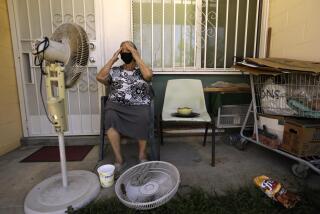Let the Sun Keep Your Swimming Pool Hot
- Share via
QUESTION: I want to get several more months use out of my swimming pool each year. I would like to use a solar heating system, but I don’t want big collectors on the roof. What solar energy options do I have?
ANSWER: Heating swimming pool water is probably the most efficient and effective use of solar energy. Installing an inexpensive solar system can easily extend your swimming season by several months. Most of these systems are designed for the do-it-yourselfer to reduce costs. Your existing filter pump circulates the water through the solar system.
There are new designs of swimming pool solar systems that don’t require big collectors on your roof. Some don’t use any roof collectors at all. Others use special flat collectors that can barely be seen from the ground.
One efficient solar system uses a special heat exchanger mounted inside the attic. The sun shining on your roof heats the attic air. The heat exchanger draws heat from the hot attic air and transfers the heat to the swimming pool water.
This system not only provides free solar heat for your swimming pool, but it also reduces excessive heat buildup inside your attic. This cuts your air-conditioning costs and cools hot ceilings in the summer.
Another no-roof-collector design uses the deck around your swimming pool as the solar collector area. Although the do-it-yourself pool deck looks like a conventional deck, it is designed with water channels inside it. As the swimming pool water circulates through the deck, it is heated by the sun. The pool water also keeps the deck area cooler on hot sunny days.
Swimming pool solar roof collectors are the simplest and lowest cost of all collectors. Since the pool water temperature is relatively cool, the collector does not necessarily need to be insulated or covered with glass.
Many of the do-it-yourself swimming pool solar collectors are made of either rigid or flexible black plastic. They consist of many small tubes. The water flows through these tubes and is heated by the sun. Some of the flexible collectors are sold in a roll and you unroll them on the roof.
These special black pool collectors lay flat against your roof and will match most dark shingles. There are two pipes at the ends connecting the many small collector tubes to the swimming pool.
You can install an automatic sensor that lets pool water flow through the collector only when the sun is shining bright enough to heat the water. In midsummer, you can operate the system at night to actually cool the water.
You can write to me at the address below for Utility Bills Update No. 280 listing addresses and telephone numbers of manufacturers of these new types of do-it-yourself swimming pool solar systems, heat output specifications, and product information. Please include $1.50 and a self-addressed business-size envelope.
Swimming Pool Solar Heater The sun’s heat can be used to warm swimming pools by running water through recirculating pipes. Systems may be used as part of pool deck, on roof top blending in with shingles, or inside attic where heater does double duty by reducing excessive heat buildup in attic.
Cracked Window Leaks Cold Air; Replace It
Q: I have a cracked pane of glass in one of my windows and I think I can feel a slight air leak through it. Does much air leak in a crack and what is the easiest way to repair it?
A: Quite a bit of air can leak in and out of a crack in window glass. The size of the crack can vary depending on weather conditions and the season. You should replace it with a new pane.
Wear heavy gloves and glasses when removing the old glass. Using a heat gun will often soften the old caulk or putty. Remove the glass and clean out all the old putty. Then paint the wood before installing the new glass. This seals the wood to prevent future moisture damage.
Caulking Best Way to Seal Air Leaks
Q: On a windy day, I feel a draft coming out from the baseboards around the walls. What is the best way to seal up those leaky areas and stop the drafts?
A: There are hundreds of feet of baseboard in most houses and it would be impossible to seal it all. Even if you could seal it all, the air would just leak in other gaps, like electrical outlet covers.
Your best method to stop the drafts is to block them at their sources. These commonly are cracks and gaps in the exterior of your house. Typical spots are where the chimney meets the house, around outdoor water faucets, electrical outlets, and around window and door trim. Use a good quality outdoor caulk that stays flexible when cured.
Clean Refrigerator Coils Every 3 Months
Q: I just bought a new refrigerator. How often I should clean the condenser coils?
A: It is extremely important to keep the refrigerator condenser coils clean. These are the coils that transfer the heat from the refrigerator interior to the room air. Adequate air flow through these coils is necessary for high efficiency and long life.
Generally, every three months is enough, but follow the manufacturer’s recommendations for cleaning frequency. If your house is very dusty or you have a long-hair dog that sheds, more frequent cleanings are advisable.


